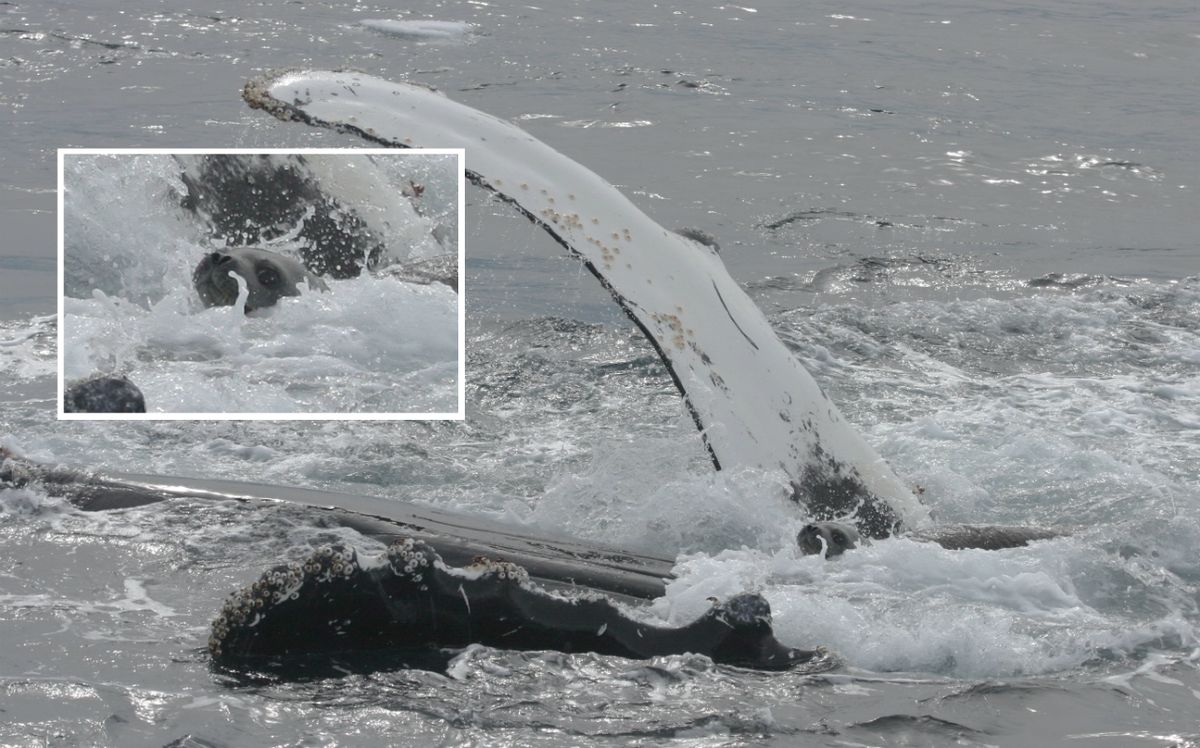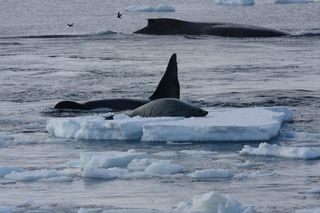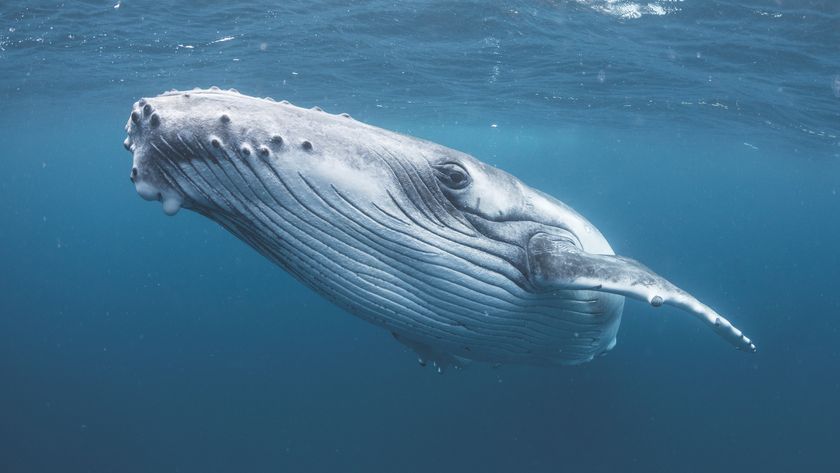Saved by the Whale! Humpbacks Play Hero When Orcas Attack

The photo is extraordinary. In waters near the Antarctic peninsula, an enormous humpback whale floats on its back, cradling a Weddell seal on its chest and elevating it above the ocean surface. Only moments earlier, the seal was perilously close to becoming dinner for a group of hungry killer whales.
Biologist Robert Pitman snapped the image while on a research expedition in 2009 — but it wasn't the first time he had observed this unusual protective behavior.
Just one week earlier, Pitman, a researcher with the Southwest Fisheries Science Center in the NOAA Fisheries Service in California, saw a pair of humpbacks aggressively confronting killer whales that were circling a lone seal on an isolated ice floe. The humpbacks plowed between the killer whales and the trapped seal, vocalizing and churning the water with their flippers, and shielding the seal until the orcas gave up and swam away. [Daring Duos: Unlikely Animal Friends]
Pitman wrote about both encounters in an article published in the November 2009 issue of the magazine Natural History, but that was only the beginning of a much longer and more in-depth investigation. In a new study, Pitman explores dozens of examples presenting humpback whales as unlikely marine vigilantes, ganging up on predatory killer whales that try to attack other species.
His research analyzed 115 interactions that took place between humpbacks and killer whales, observed by more than 54 individuals — scientists and non-scientists — in ocean locations around the world and spanning 62 years, from 1951 through 2012.
The study found that large and powerful humpback whales, the only whales known to attack orcas, will band together and sometimes travel great distances to interrupt and terminate a killer whale attack, regardless of what type of animal the orca is attacking.
Humpbacks to the rescue
Adult humpbacks usually don't have much to fear from killer whales. Observers' accounts suggested that when killer whales approached humpbacks, they were targeting the more vulnerable calves or juveniles as prey, the study authors wrote.
Sign up for the Live Science daily newsletter now
Get the world’s most fascinating discoveries delivered straight to your inbox.
But humpbacks frequently turned the tables on their would-be attackers. Observers also described numerous reports of humpbacks — alone and in groups — making the first move, approaching killer whales that were already pursuing other prey. Sometimes the orcas' victims were humpback mothers with young calves. But belligerent humpbacks also appeared when orcas pursued other whale species, or even seals and sea lions. The humpbacks would slap their tail flukes and flippers in the water, and make loud "bellowing" sounds to drive the orcas away.
Humpbacks' whale-deterring moves typically lasted for at least one hour and could extend for as long as seven hours, the authors wrote. And according to observers, the whales' intervention often allowed the orcas' prey to escape.
One account in the study described a killer whale attacking a gray whale mother and calf, when "out of nowhere, a humpback whale came trumpeting in." Four more humpbacks shortly followed, which the observer found odd because no humpbacks had been sighted in the area before then. Their timely arrival allowed both calf and mother to flee to safety, the researchers said. [Real-Life 'Zootopia': Mongooses and Warthogs Are Unlikely Pals]

Heeding distress calls
The sounds made by attacking orcas may be what draw humpbacks to the scene — even when they're nearly a mile away, the authors suggested. Killer whales are silent and stealthy when stalking their prey, but become highly vocal once they attack. Humpbacks could recognize this sound from orca attacks on their own young, and respond even when they don't know what species the killer whale is targeting.
But why would humpbacks put themselves at risk to protect animals that aren't even their close relatives? They aren't known to mingle with seals and other whales under normal circumstances, Pitman told Live Science in an email.
"Sometimes different species will collect in an area of abundant prey," he said. "But usually there are no direct interactions."
The protection the humpbacks' behavior offers to other species is probably very welcome — but is likely unintended, the study authors said.
"A simple behavioral rule like 'interfere with attacking killer whales' may prevent a related calf from being killed," Pitman explained, "and it may also help out other species at times."
Since the risk to a healthy adult humpback from a killer whale is low, the benefit of possibly saving a humpback calf could outweigh the high-energy cost of putting themselves in harm's way — even if the animal they're saving isn't always a humpback, Pitman said. [Whale Album: Giants of the Deep]
Friends and allies?
There is indeed a great deal yet to be learned about the motivations of these hero humpbacks, but is the idea of animal altruism really so unusual? Animals of the same species that live in groups are known to band together to drive off a threat, to collaborate in complex construction projects, to hunt for food or to attack rivals.
And even different species that would typically never interact can form close bonds when introduced at a young age — such as a leopard and golden retriever that were raised together in South Africa.
But do animals in the wild experience compassion or concern for other species that go beyond the need to protect themselves and their young? Animals can't tell scientists about their intentions. And while it may be tempting to interpret their behavior through a human lens, there is still much that eludes easy explanation, according to the researchers.
"I think we need to consider the possibility that altruism can be unintentional and arise out of self-interest, as we suggest for the humpbacks," Pitman said.
He said that current understanding of whale behavior is also hampered simply because whales are scarce. Whaling throughout the 20th century drastically reduced their numbers, and many populations that were nearly eliminated are only recently beginning to rebound.
"As their populations continue to recover, and we learn more about how they interact with each other and their environment, we could be in for some surprises," he added.
The findings were published online July 20 in the journal Marine Mammal Science.
Original article on Live Science.

Mindy Weisberger is an editor at Scholastic and a former Live Science channel editor and senior writer. She has reported on general science, covering climate change, paleontology, biology and space. Mindy studied film at Columbia University; prior to Live Science she produced, wrote and directed media for the American Museum of Natural History in New York City. Her videos about dinosaurs, astrophysics, biodiversity and evolution appear in museums and science centers worldwide, earning awards such as the CINE Golden Eagle and the Communicator Award of Excellence. Her writing has also appeared in Scientific American, The Washington Post and How It Works Magazine. Her book "Rise of the Zombie Bugs: The Surprising Science of Parasitic Mind Control" will be published in spring 2025 by Johns Hopkins University Press.











